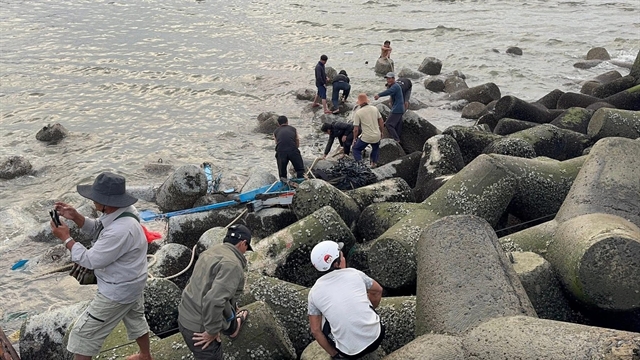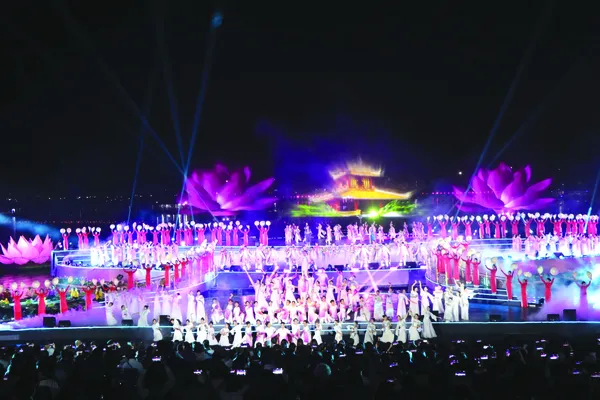 Features
Features

Việt Nam’s famous traditional dress, the áo dài, has undergone many transformations over the years to reach its current form, and its allure and appeal has never died.
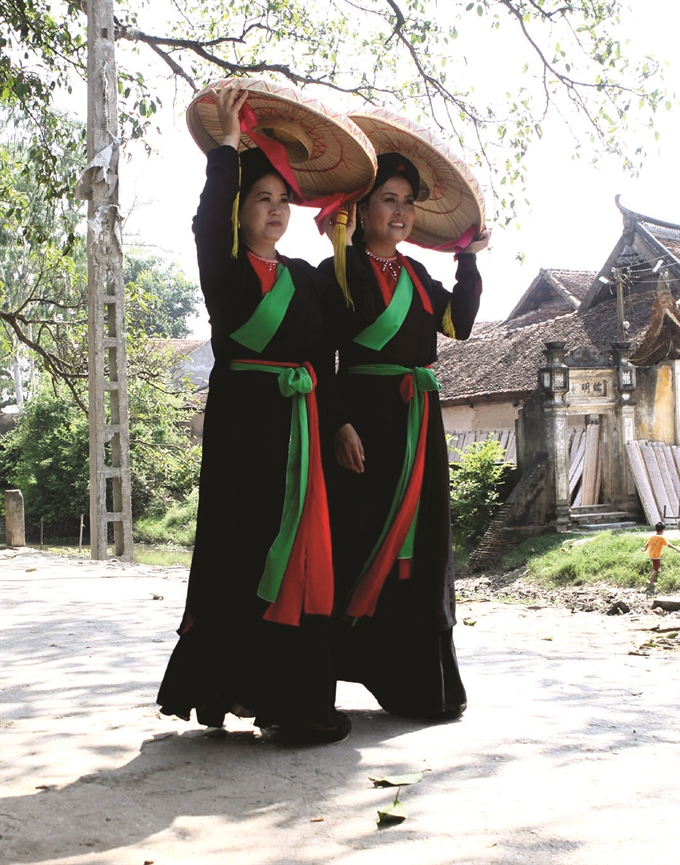 |
| Long history: Áo dài’s evolution dates back to the 19th century, when it was born from áo tứ thân (four-flap dress), a loose dress worn outside a white thin blouse over a halter, along with a fabric belt. Photo Anh Tuấn |
Though Việt Nam’s famous traditional dress has taken many forms over the centuries, its allure and appeal has never died.
People all over Việt Nam are familiar with poems featuring the beauty of the country’s national dress, the áo dài, its slim-fitting tunic with long side splits from the waist, worn over palazzo-style trousers. The traditional woman’s dress has been mentioned in many poems, stories and songs for centuries.
Poet Đinh Vũ Ngọc likened it to the country’s S-shape in her poem Chiếc Áo Dài Việt Nam, which was roughly translated as:
"The fatherland’s dress, slender shape
"The national beauty split into two flaps
"The flap on the side of the East Sea with sparkling waves
"The flap on the side of the Trường Sơn Mountains is brilliant with flowers
"The wide flap in the South flying in the wind
"The waspy waist of the Central region
"The heartbeat of Hà Nội on the chest
"The fragrance of three regions, the fragrance of flesh.
The áo dài is considered by Westerners to be one of the most elegant and feminine national costumes in the world with its close-fitting bodice, free-flowing front and back panels, and long silk trousers.
It is a delicate and airy garment.
But many people are unaware that it has undergone many transformations over the years to reach its current form.
Its evolution dates back to the 19th century, when it was born from the áo tứ thân (four-flap dress), a loose dress worn outside a white thin blouse over a halter, along with a fabric belt.
The Vietnamese at that time wanted to simplify it and joined the two narrow panels, setting the stage for the very first appearance of the modern áo dài.
In the 1930s, it was transformed into a gown with two elegant panels reaching to the ground, fitting the wearer’s body by using pins and a nipped-in waist. It had a raglan sleeve based on Western fashion techniques, which eliminated the clumping of material under the arms of the áo dài, bringing it a step closer to its current form-fitting style.
Until 1958, the áo dài was a daily outfit in the North, but by that time, it had fallen out of fashion in the trendier South.
Trần Lệ Xuân, the wife of a brother of the former president of South Việt Nam Ngô Đình Diệm, infamously known as the “Dragon Lady”, made a fashion statement by wearing an áo dài with a bateau neckline and snug upper body, influencing nearly all Southern women to wear the style.
The bateau style remained popular until the 60s when the hippie trend reached Sài Gòn, and knee-length panels then became de rigueur.
Following reunification and post-war depression, fabric became more expensive, so women shifted to the áo bà ba, a simpler version of the áo dài with the flaps ending at the hipline and a front button used for access.
The áo dài was then relegated to use for special occasions and diplomatic events.
In recent years, artists and people who love the costume have managed to resurrect its use in daily life.
For three consecutive years, the southern commercial hub of HCM City, for example, has organised the áo dài festival to preserve national traditional culture and embed the national dress in the cultural and spiritual life of its citizens.
During this year’s festival, which was held over one month, the city encouraged its residents to wear the áo dài every day.
“Vietnamese women should wear the áo dài at school and at work as well,” Đặng Thị Trúc Linh, a senior at the HCM City University of Social Sciences and Humanities, said, while working as a volunteer at the opening ceremony of Áo Dài Festival 2016.
“Though these long, flowing panels are something of a hazard when riding a bicycle or sitting side-saddle on a motor scooter, the áo dài’s advantages far outweigh its drawbacks as it helps to hide unshapely legs, thick ankles and knobby knees,” Linh added.
Nguyễn Thị Hồng Hạnh, a visitor to the event, said: “Firstly, the áo dài makes wearers feel pretty and charming. Secondly, it’s very practical. We don’t have to wonder what to wear every day.”
However, Trần Thị Tú Uyên, a journalist at the Pháp Luật newspaper, said that if the city requested every female official to wear áo dài to work, she would obey.
“But my career requires a more modern costume, like jeans,” Uyên said.
“The plain white áo dài can be a common uniform in high schools as wearing it can teach students how to behave. It can impart modesty, caution and refinement.
“We should also let others have the freedom of choice to wear what they want,” Uyên added. “We can see the trend of wearing áo dài blooming in the city in recent months. They’re now more fashionable and more modern in many colours with shorter flaps, and they can be worn with jeans.”
Diệu Anh, a fashion designer who follows the trend, said: “the áo dài is beautiful only when people wear it voluntarily and confidently. Fashion is not only about wearing something beautiful but also about revealing your personal characteristics. When the áo dài can satisfy all these criteria, there will be no reason to prevent people from choosing their own áo dài.”
Anh said that many competitions over the years have been held to choose the country’s favourite national costume.
“But it resulted in nothing,” she said. “Then, as natural as the wind, the áo dài, over time, with its widely diversified designs, has roused the long tradition of the country, and its popularity has spread thanks to the love of the people who wear it.”
In an online discussion recently held by a local newspaper about whether female students at high schools should wear the áo dài, some readers said they were disappointed that uniforms had changed to shirts and skirts or a shirt and trousers in a variety of styles and colours.
“In the 80s, the Ministry of Education and Training required female students to wear the áo dài, which created beautiful images of groups of students riding bicycles with the white áo dài flying in the wind,” Cao Nguyên, 21, said. “That image is no more. What a pity!”
Others said wearing the áo dài in hot weather causes difficulties for students. School uniforms should be aesthetically and climatically appropriate, and simple and cheap, help girls be comfortable while they study at school.
Áo dài can be worn on Mondays when they take part in the flag-saluting ritual, or on national holidays.
“If people wear áo dài in daily life, the dress’s beauty and significance tends to be less appreciated as the national costume,” Huỳnh Trung Nghĩa, 55, said.
Famed áo dài designer Thuận Việt said that the áo dài at schools should be made with moisture-absorbing materials and have several adjustments, including a low upright collars, looser-fitting tunic and shorter and narrower pants.
“We should have a 2-cm collar, and flaps ending at 15cm at 25-cm wide cuffs for the convenience of female students,” Việt added.
Modernising the áo dài
Sỹ Hoàng, a well-known designer whose name is connected closely to the áo dài, said people were now thinking of modernising the áo dài. But the dress has already gone through a period of modernisation.
“The áo dài, traditional but not conservative, has always been modernized to meet the aesthetic taste of people in each period,” Hoàng said.
“The áo dài that people consider modern now is truly the áo dài of the 70s,” he said. “The convenient and modern áo dài freed women and helped them to become more active. Let each person decide what kind of áo dài they want to wear.”
“Áo dài is a costume that will never be out of date. It is worn by all people of all social classes and gender, and I believe that the costume has a beginning but will not have an end,” he added
Since 1997, Hoàng has shown his áo dài designs in 20 countries. In 2006, one of his collections is on permanent display at the Museum San Jose of Quilts and Textilles in San Jose in the US.
Hoàng has introduced his áo dài collections that combine traditional áo dài with costumes of other countries, including France, the US, China, Japan, the Philippines Singapore, South Korea, and India.
“We need to internationalise the áo dài, and create a trend of wearing áo dài worldwide,” Hoàng said. “Foreigners should wear áo dài as a costume of fashion, beauty and convenience.”
Dương Thanh Thủy, a representative of the Trung Thủy corporation, which is well-known for the brand Miss Áo Dài, said she was embarrassed when tourists ordered traditional áo dài as there is no clear definition about what a traditional áo dài is.
“Is the áo dài of the 30s, 40s or 60s considered traditional? Should we develop standards to define a traditional áo dài?” Thủy said
Despite the disagreements over the design and definition of the áo dài, many people, as well as the government, want to continue to show off their love of the national costume.
Last year, Nguyễn Thị Thu Thủy, also known as Juliette Nguyen, who attends the William Angliss Institute in Melbourne, created a fanpage on Facebook named “Ao Dai around the World”, encouraging people to send photos of themselves wearing the traditional Vietnamese costume.
“This is a community project of a young girl who loves her traditional Vietnamese dress and wants to share it with the world,” her Facebook page says.
Every day, the page posts about two to three photos with captions depicting the readers’ stories.
Thủy writes on her page: “You can see her [Thủy] somewhere in photos on this page. She always takes photos of herself in every single place she has visited. This is not her page, it is the ‘Ao Dai Around the World’ page and an ao dai lover’s page. She will be much happier if this page becomes a community project. So friends, no matter who you are, where you go, whatever your gender or nationality, please share with the world a photo of you in an áo dài. She might not be in all countries or all provinces and cities around the world. But together, we can do it.”
So far, 3,595 Facebook users have liked the page and have uploaded thousands of photos capturing the áo dài in 40 countries.
One reader, who uploaded her photo last week, wrote: “I was so happy that I brought the áo dài with me on my trip to Europe. The Vatican was a perfect place for it! Places where there were lots of restrictions on clothing, the áo dài made me stand out, and, of course, I got lots of attention.” VNS
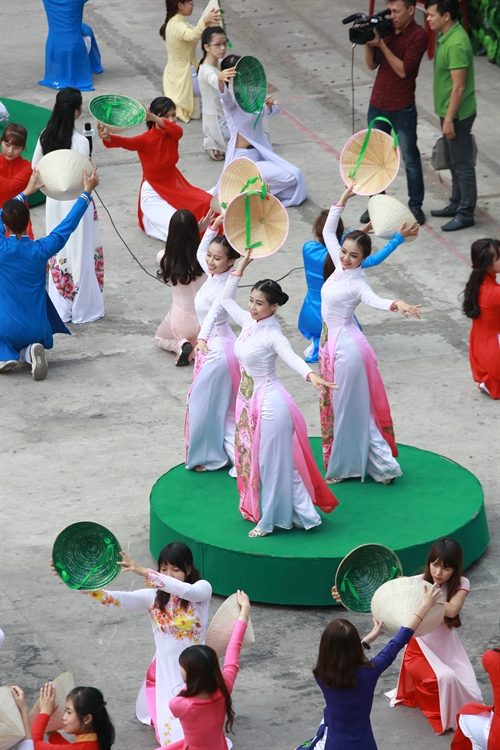 |
| Elegant dress: More than 1,000 people wore áo dài at the opening ceremony of the HCM City Áo Dài Festival 2016. – VNS Photo Đào Quang Châu |
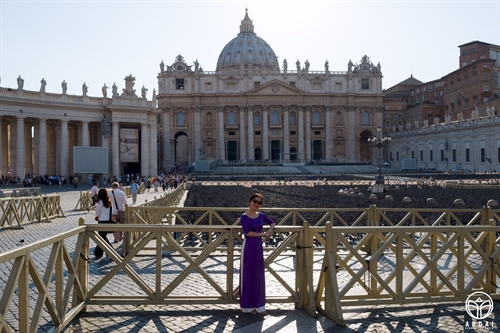 |
| Globetrotting: Áo dài is worn at the Vatican. - VNS Photo from the fan page Ao Dai Around the world |
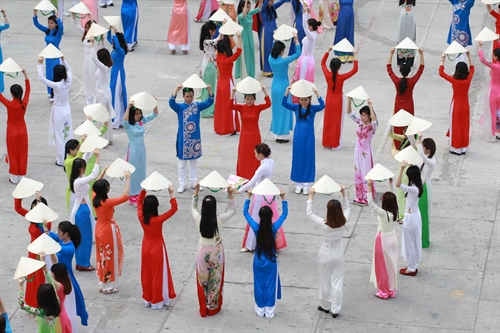 |
| Hats off: More than 1,000 people wore áo dài at the opening ceremony of the HCM City Áo Dài Festival 2016. – VNS Photo Đào Quang Châu |
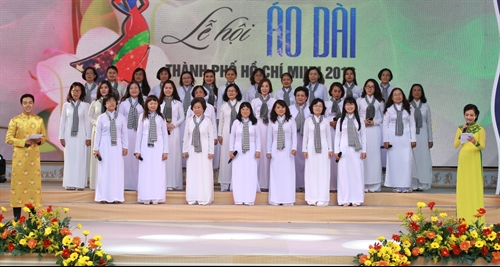 |
| Ladies in white: A chorus performs at the HCM City Áo Dài Festival 2016. – VNS Photo Nguyễn Tấn Đạt |
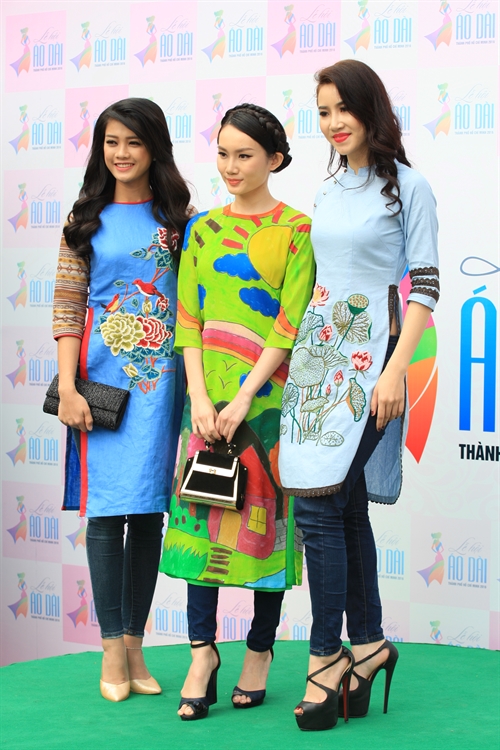 |
| Modern twist: Women in modern áo dài at the HCM City Áo Dài Festival 2016. – VNS Photo Đào Quang Châu |


